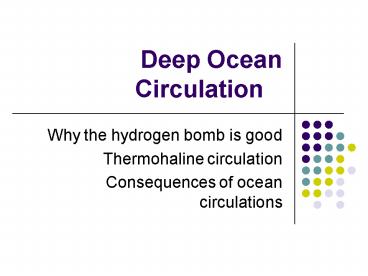Deep Ocean Circulation PowerPoint PPT Presentation
1 / 34
Title: Deep Ocean Circulation
1
Deep Ocean Circulation
- Why the hydrogen bomb is good
- Thermohaline circulation
- Consequences of ocean circulations
2
(No Transcript)
3
Ocean topography shows us that the major global
downwelling occurs in polar regions
4
Ocean circulations
- Surface ocean circulations are driven by winds
- Deep ocean circulations are driven by differences
in density
5
Density
- Mass/Volume
- Two processes are mostly responsible for changes
in density in the ocean - Temperature
- Salinity
- Density changes are larger vertically than
horizontally
6
Salinity
- A measure of the amounts of salt in the ocean
- Measured by parts per thousand, or per mil
- Equal to grams per kilogram
- Most of the ocean salts are chloride and sodium,
the ingredients of table salt - Produced by rock weathering and transport by
rivers - Removed by evaporation, biological and volcanic
processes, and sea spray
7
Salinity variation
- The global variation in salinity is the result of
a balance between the inputs and outputs of salts
and fresh water - So areas with high evaporation and low input of
fresh water will have high salinity - Great Salt Lake, Red Sea, Mediterranean
- Coastal boundaries of oceans have lower salinity
because of river input
8
(No Transcript)
9
(No Transcript)
10
Effects of salinity
- Increases in salinity make water more dense than
fresh water
11
Temperature
- Colder water is denser than warm water
- Densest water is 4 deg C
12
(No Transcript)
13
Vertical profiles
- The top surface 100-200 meters are called the
mixed layer - Below this is a transition zone of about 1000m
- Below the transition zone is the deep zone
14
Pycnocline Thermocline
Halocline Pycnodensity
Thermoheat Halosalt
15
Pycnocline
- The overall profile of density change with depth
in the ocean, called the pycnocline, can be
formed by a thermocline, halocline, or
combination of the two - Temperature changes are usually more important
16
Transition zone
- This zone, characterized by sharp increases in
density, is very stable - Not much mixing can occur across this gradient
- Water movement occurs along sloping line of
constant density
17
Deep zone
- 80-90 of ocean volume is contained in the deep
zone below 1000m - Characterized by small gradients of temperature
and salinity
18
An apparent conundrum
- How can we have a deep ocean circulation if the
profile of the ocean is so inherently stable?
19
Polar waters
- The surface of polar waters is relatively denser
than other surface waters - Especially in winter
- Cold temperatures
- Formation of sea ice increases the salinity
- So there is less of a density gradient in polar
regions
20
Polar mixing
- Polar surface waters can become so dense that
downwelling occurs - Isopycnal mixing
21
Regions of deep water formation
- The dense water needed to drive the ocean
circulation is produced in two polar areas - Greenland, forming the North Atlantic Deep Water
(NADW) - Antarctica, forming the Antarctic Deep Water
(AADW) in the Weddell Sea
22
NADW
Antarctic Deep Water (Weddell Sea Ice)
23
Global salinity
- Geographic variation of salinity also has a major
impact on ocean circulation
24
GLOBAL VARIATION IN SALINITY Atlantic
evaporation exceeds precipitation and river
inputs. Input of saline water from the
Mediterranean and Caribbean Seas Pacific
evaporation about equal to inputs Consequence
major Atlantic-Pacific gradient in salinity
25
Thermohaline circulation
- The combination of the deep water formation and
salinity differences (both from sea ice formation
and oceanic differences), leads to the
thermohaline circulation - Thermoheat
- Halinesalt
- Acts to redistribute energy and salinity
26
Major source
- The Atlantic is the major pump for the
thermohaline circulation - Atlantic goes farther towards the poles and thus
gets colder (more dense) - Has higher salinity (more dense)
27
The thermohaline circulation (global ocean
conveyor belt)
28
Actions of the conveyor belt
- Bring cold water from the poles toward the
equator - Bring warm water from the equator toward the
poles - Acts to limit salinity differences
29
Ocean differences
- Atlantic, with denser water, has an average deep
water age of about 275 years - Pacific, with less dense water, has an average
age of about 510 years
30
This figure, showing the distribution of tritium,
is direct proof of the theoretical concept of the
thermohaline circulation deep water formation
only occurs in polar latitudes
31
Coriolis effect?
- Yes, but strongly limited by the deep ocean
topography
32
Overall effect of ocean circulations
- We have a known imbalance in the global energy
budget - Both the atmosphere and the ocean regulate this
distribution - About 50 each
33
Local effects of ocean circulations
- If prevailing winds are from a warm ocean to
land, this greatly moderates the climate - Pacific Northwest
- Europe
- If prevailing winds are from a cold ocean, cold
deserts result - Southern Chile (Patagonia)
34
Biological effects of deep water movement
- Photosynthesis in upper water
- Leads to phytoplankton
- Leads to zooplankton, etc.
- Organisms in these areas die, sink, and decompose
- Releasing their nutrients to the deep water
- Thus the upwelling of cold, deep water brings
nutrients back to the surface

